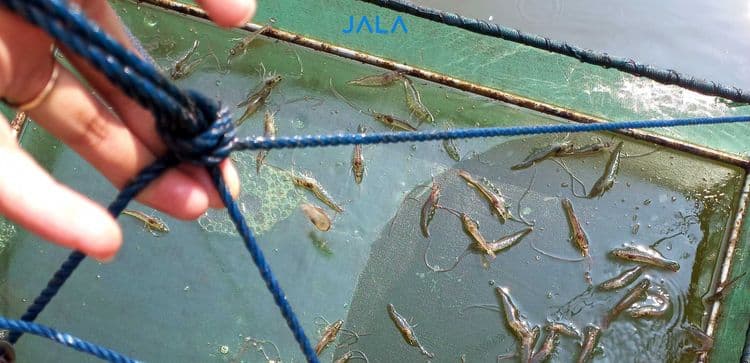
Bacterial disease in shrimp farming is a disease caused by pathogenic bacteria. AHPND, white feces disease or WFD, Vibriosis, and black spot disease are all bacterial diseases and are caused by the Vibrio bacteria.
Bacterial diseases on shrimp
AHPND
Acute Hepatopancreatic Necrosis Disease (AHPND), or also known as Early Mortality Syndrome (EMS), is a bacterial disease caused by Vibrio parahaemolyticus. AHPND can also be caused by overfeeding, poor feed, fry, and water quality, as well as algae blooming, in addition to bacteria. Shrimp infected with AHPND will display various physical indications, including the hepatopancreas turning pale, shrinking, and not breaking easily, the shell is soft, the intestine is empty, and the black spots or stripes on the hepatopancreas.
White Feces Disease
Declining water quality and accumulated residual feed cause organic substances to appear in ponds, which then trigger infection of White Feces Disease (WFD). Elongated white feces that appear in ponds is a sign of this disease. Meanwhile, two physical effects of WFD in shrimp are the exfoliation of the skin and the presence of worm-shaped parasites in the shrimp intestines. White feces can significantly lower the survival rate, impede shrimp growth, and reduce feed efficiency.
Vibriosis
Vibriosis is a disease caused by Vibrio bacteria infection. Shrimp with Vibriosis will emit halogen light. This disease infects shrimp larvae more frequently than it does to adult shrimp, and usually infects when the larvae are stressed.
Black Spot Disease
Black Spot Disease is caused by Vibrio anguillarum which is capable of spreading in water. The shrimp infected by this disease have black spots and a brownish color on their carapace. Poor water quality and excessive levels of organic feed residue at the pond's bottom are the other contributing causes. This disease usually happens after harvest.
The life cycle of bacterial disease in shrimp farming
Bacteria live in the environment by consuming nutrients from organic substances. Moreover, bacterial disease can infect shrimp in farms through water pumped to supply ponds. Besides water, bacterial disease can get into farms through mud, wild crabs and shrimp, crustaceans, and molluscs that get pumped with the water.
Bacterial disease then spreads in the farm by consuming organic substances from pond sediment, such as shrimp feces, feed residue, and dead plankton. When reaching quorum sensing, bacterial disease can start infecting shrimp.
Dead shrimp, sediment, and water containing bacterial disease that are discharged to the waters surrounding the farm without further management will harm the environment. This waste has the potential to change the ecological conditions of the environment and cause the spread of bacterial disease.
Preventing bacterial disease to get into shrimp farms
Once the disease gets severe and not treated immediately, the bacterial disease cycle will continue, increasing the risk of shrimp death. Thus, this issue must be avoided.
Farmers can take precautions by controlling biosecurity, circulating water regularly, managing pond wastewater, and treating water before it is utilized for cultivation. By managing feeding in accordance with the shrimp population and their potential for growth, farmers can also reduce the accumulation of organic substances in ponds.





